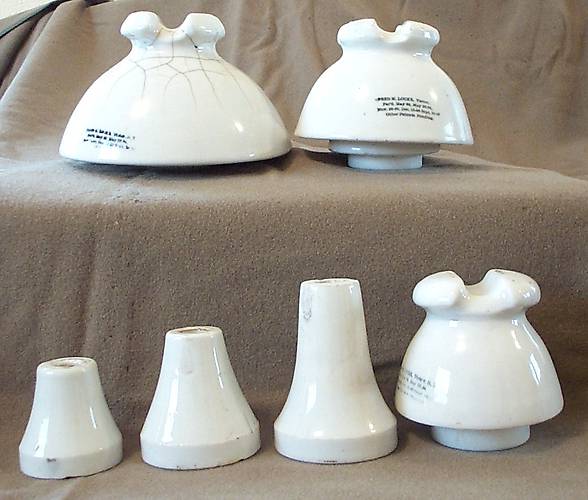The Electrical Porcelain and Manufacturing Co 1898-1899
By Mike Spadafora; posted April 10, 2013
View Original: Click to zoom, then click to magnify (1026 x 873) 204KB

|
Shown here are all the insulators currently attributable to the Electrical Porcelain And Manufacturing Co( of Trenton, N.J.) with some degree of certainty. The U-927, U-927a U-939 and three pin base sizes are all that have been reported to date . All these pin types were produced for resale by Fred M.Locke in 1898-1899 . The pin bases were likely there first product having been produced as early as 1897 or earlier. They did produce a few other pin base sizes as shown in old trade journal adds, but none have been reported to date ether . There was also at least one other pin type, the U-939a, which has also not been reported to date with characteristics that make it a likely EP&M product as shown in old advertisements. All three pin types use the same dry process threaded centre section and have various wet process outer skirts and applied crowns . These insulators were distributed through Fred's new Victor, N.Y. factory and a few occasional shards can be found in the Victor dump along with Locke / Brookfield produced glass of the same era. All of these insulators were made "twice fired" once in a bisque state and a second firing after the glaze was applied. All the EP&M Co specimens have marking 5-1 or are unmarked . This marking stamp does not appear on any other Fred Locke insulators All three pictured pin bases are dry process porcelain and have a recess embossed marking on the base that was part of the dry process mold. The large U-927 is thought to have seen service in the Honolulu, Hi. The U-927a cross top saw only one known installation near Boise, Id in early 1898 which also used the mid sized pin base pictured here. The U-939a has been found only in the Roslin, BC, Canada area, again installed sometime in 1898. A few of the small pin bases shown here also came from that same area. These pieces were briefly produced during the period after Imperial discontinued making Fred's insulators but before the Victor factory reached full productive capacity around 1899. The tall pin base was for use with long skirted insulators like the CD 288 Mershon . |